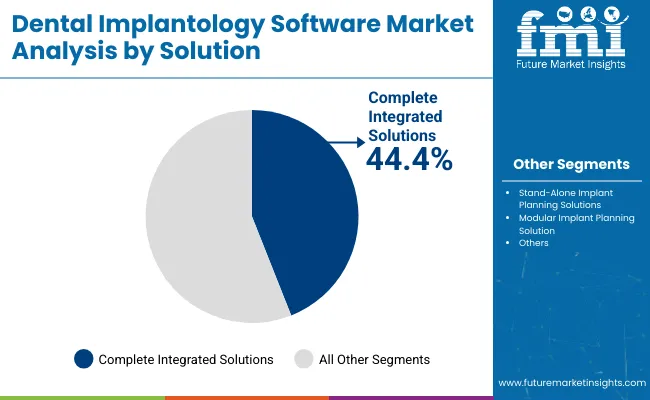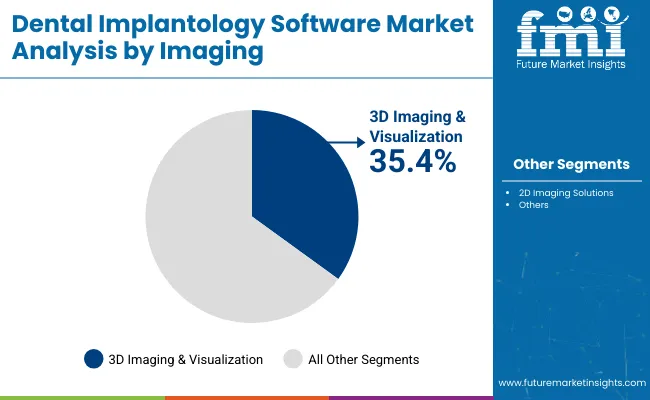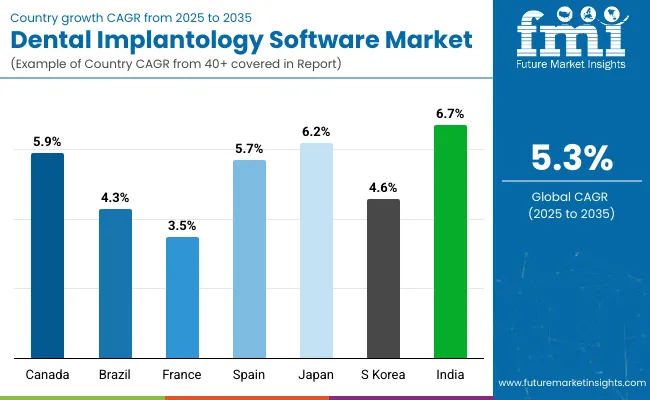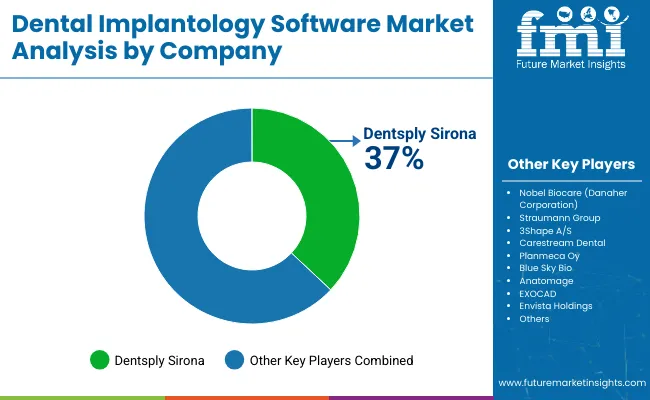The dental implantology software market is projected to expand from USD 240.6 million in 2025 to USD 402 million by 2035, growing at a CAGR of 5.3% over the forecast period. Global sales reached USD 225.7 million in 2024 and are expected to post steady year-on-year gains. Market growth is being propelled by the rising demand for personalized dental care and the increasing shift toward digital dentistry.
Software solutions for pre-surgical planning, 3D visualization, surgical navigation, and prosthetic-driven implant planning are enhancing treatment precision, reducing procedural risks, and improving patient outcomes-factors contributing to their widespread adoption.
Adoption of dental implantology software is accelerating globally as dental practices transition from conventional workflows to fully digital operations. Innovations in artificial intelligence (AI) and machine learning (ML) are allowing dentists to automate complex processes, optimize diagnostics, and facilitate implant planning with enhanced accuracy.
Developed markets such as the United States, Germany, and Japan are driving early adoption due to advanced dental infrastructure and high patient awareness. Meanwhile, emerging economies are witnessing rapid growth, supported by government initiatives to expand access to dental care and growing investments in dental technology.
The future market outlook remains highly positive, fueled by the availability of modular and cloud-based solutions that make advanced software more accessible to smaller clinics and resource-constrained settings. Additionally, trends such as dental tourism are driving demand in countries like India, Thailand, and Mexico, where clinics are leveraging implantology software to attract international patients and gain a competitive edge.
As Steve Boggan, CEO of BioHorizons, stated in an interview featured on dentistryiq.com and investor.zimvie.com: “Treatment planning software has become an important aspect of implant dentistry. However, clinicians are often reluctant to use the technology because of the cost and steep learning curve. The competitively-priced, user-friendly interface of VIP 2.1 addresses these concerns, enabling a larger portion of the dental implant community to treatment plan virtually with ease and accuracy.”

| Attributes | Key Insights |
|---|---|
| Market Size (2025) | USD 240.6 million |
| Market Size (2035) | USD 402 million |
| CAGR (2025 to 2035) | 5.3% |
Major companies are transforming dental implantology by integrating smart technologies such as AI, robotics, and cloud-based software to enhance precision, streamline workflows, and improve patient outcomes. These innovations enable dentists to perform complex implant procedures with higher accuracy and reduced time, revolutionizing traditional dental practices.
Governments around the world play a vital role in advancing the dental industry by providing financial support, regulatory oversight, and public health initiatives. Their efforts help drive innovation in dental technologies, including implantology and digital dentistry, while ensuring patient safety and expanding access to quality care.
In the first half (H1) of the decade from 2024 to 2034, the business is predicted to surge at a CAGR of 6.0%, followed by a slightly lower growth rate of 5.7% in the second half (H2) of the same decade.
| Particular | Value CAGR |
|---|---|
| H1 | 6.0% (2024 to 2034) |
| H2 | 5.7% (2024 to 2034) |
| H1 | 5.3% (2025 to 2035) |
| H2 | 4.8% (2025 to 2035) |
The above table presents the expected CAGR for the global dental implantology softwares market over several semi-annual periods spanning from 2025 to 2035. Moving into the subsequent period, from H1 2025 to H2 2035, the CAGR is projected to decrease slightly to 5.3% in the first half and decrease moderately at 4.8% in the second half. In the first half (H1) the market witnessed a decrease of 70 BPS while in the second half (H2), the market witnessed a decrease of 90 BPS.
The dental implantology software market is evolving with growing adoption of advanced digital tools across dental practices and laboratories. Complete integrated solutions are emerging as the preferred choice for seamless clinical workflows. Meanwhile, 3D imaging & visualization applications are transforming treatment planning and outcomes, driving significant investment and innovation across the market.

Complete integrated solutions are projected to hold a dominant 44.4% market share in 2025 within the dental implantology software market. These solutions streamline the entire dental implant workflow-from patient diagnostics and treatment planning to surgical guide creation and final prosthesis fabrication.
Leading players such as Dentsply Sirona, Planmeca Oy, 3Shape, and Straumann Group offer comprehensive software platforms that connect 3D imaging, CAD/CAM design, and practice management systems in a single environment. Integrated solutions improve clinical accuracy, reduce chair time, and enhance the patient experience through predictable outcomes.
With rising demand for personalized dental restorations and faster treatment turnaround, dental professionals increasingly prefer solutions that offer interoperability with digital scanners, CBCT imaging, and milling/3D printing devices. Furthermore, software ecosystems built around cloud connectivity and AI-driven planning tools are reinforcing the shift toward completely integrated platforms. As digital dentistry adoption continues to accelerate globally, this segment is poised to maintain a strong growth trajectory.

The 3D imaging & visualization segment is expected to command a significant 35.4% market share in 2025, underscoring its growing importance in modern dental implantology. These applications enable practitioners to visualize anatomical structures in detail, improving diagnostic accuracy and enhancing surgical planning.
Companies like Carestream Dental, Planmeca Oy, Align Technology, and Acteon Group are innovating in this space with high-resolution imaging software integrated with CBCT scanners and intraoral scanners. 3D imaging empowers clinicians to assess bone density, nerve positioning, and implant angulation with greater precision. This capability minimizes surgical risks and optimizes implant placement, which directly impacts treatment outcomes.
The integration of AI-based visualization tools is further enhancing the ability to simulate treatment outcomes and improve patient communication. Demand for 3D imaging & visualization is also supported by the growth of guided surgery techniques and patient-specific treatment planning. As dental practices continue embracing digital-first workflows, this application segment will remain a key driver of software adoption in dental implantology.
The demand for dental implantology software has continued to record significant growth in recent years, propelled by a number of critical factors pointing at benefits and an increasing reliance on dental implants. Among the main reasons is the ever-increasing demand for dental implants themselves, currently considered the standard of care for the replacement of missing teeth.
This is attributed to the many superior advantages that dental implants have provided, such as reducing the risk of caries in and sensitivity of adjacent teeth and improving the maintenance of bone in edentulous sites. These advantages make dental implant treatment an attractive and more long-lasting option for patients desirous of a more durable, functional replacement for lost teeth.
Also, the increasing trend towards aesthetic dentistry is acting as one of the main driving forces for demand in the dental implantology software market. For this, dental implants with their better resemblance to real teeth are considered the prime option among the people as it will definitely help regain their smile and facial aesthetic look.
The implantation procedure is one of the most revolutionizing procedures in aesthetic dentistry at present, since it could make teeth more functional and improve their form. Thus, implants restore not just a person's ability to properly chew and speak but their facial appearance greatly improved, what greatly enhances the level of their confidence and well-being in general.
In conclusion, the increasing demand for dental implantology software is primarily driven by the growing adoption of dental implants for missing teeth, the rising focus on aesthetic dentistry, and the development of minimally invasive procedures.
The integration of 3D printing technology with cloud-based dental implantology software offers strong potential which is positively impacting the dental implantology software market by increasing not only precision but also accessibility to treatments. It could enable dental professionals to produce highly customized implants, especially made for each particular anatomy.
This will improve the precision of implant placement, improving clinical outcomes while decreasing complications and enhancing patient satisfaction. The possibility of printing an implant according to each particular need further reduces adjustments that might become necessary during the procedure; this will save a great deal of time while making procedures less costly for patients and dental practices alike.
Furthermore, an increase in cloud-based solutions is resulting in benefits accruing in dental implantology. Cloud-based applications mean that remote access by the dental practices to patient data and treatment plans opens more flexibility and convenience to their work. In addition, there is smoother collaboration between different dental professionals, even in diverse locations, for an integrated approach to patient care.
It facilitates specialists in reviewing cases, advice, and sharing insights way more easily in real time and enhances the quality of the treatment plan and results. This synergy between these innovative technologies presents a golden opportunity for growth in the dental implantology software market and thus may continue to see expansion in both developed and emerging markets.
Most of the modern dental implantology software requires a high investment in the initial stage, one of the major barriers to entry for many dental practices due to their low financial resources. High costs associated with the 3D printing apparatus, advanced implantology software, and infrastructures supporting such technologies are extremely prohibitive. This includes high-performance computers, servers, training personnel, and software licenses that inflate the initial cost.
While cloud solutions may offer relief by negating the need for on-premise hardware, reducing storage costs, and scalable pricing models, they still require substantial investments when high levels of data security and advanced features are integrated. For dental clinics on a tight budget, this initial capital outlay could delay the adoption of such technologies despite their long-term benefits.
Besides, dental practices have to consider further costs for software maintenance, updates, and training to maintain proficiency in the use of the systems among staff members. Small clinics, especially in emerging markets, may find these costs hard to justify, further narrowing the potential growth in adoption rates of advanced dental implantology software. Thus, high initial investment cost remains one of the biggest challenges that must be resolved if the market is to achieve deeper penetration and become more widely available.
Tier 1 companies comprise market leaders with a market revenue of above USD 100 million capturing significant market share of 67.4% in global market. These market leaders are characterized by high production capacity and a wide product portfolio. These market leaders are distinguished by their extensive expertise in manufacturing and a broad geographical reach, underpinned by a robust consumer base. Prominent companies within tier 1 include Dentsply Sirona, Nobel Biocare (Danaher Corporation), Straumann Group and Envista Holdings
Tier 2 companies include mid-size players with revenue of USD 50 to 100 million having presence in specific regions and highly influencing the local market and holds around 28.1% market share. These are characterized by a strong presence overseas and strong market knowledge. Prominent companies in tier 2 include 3Shape A/S, Carestream Dental, Planmeca Oy, EXOCAD among others.
Finally, Tier 3 companies, such as Blue Sky Bio, Anatomage among others are essential for the market.
The section below covers the industry analysis for the dental implantology softwares market for different countries. Market demand analysis on key countries in several regions of the globe, including North America, Asia Pacific, Europe, and others, is provided. The United States is anticipated to remain at the forefront in North America, with a value share of 92.4% through 2034. In Asia Pacific, South Korea is projected to witness a CAGR of 4.6% by 2034.

| Countries | Value CAGR (2025 to 2035) |
|---|---|
| Canada | 5.9% |
| Brazil | 4.3% |
| France | 3.5% |
| Spain | 5.7% |
| Japan | 6.2% |
| South Korea | 4.6% |
| India | 6.7% |
United States dental implantology softwares market is poised to exhibit a CAGR of 3.7% between 2025 and 2035. Currently, it holds the highest share in the North American market, and the trend is expected to continue during the forecast period.
Digital solution adoption has greatly increased due to the need to make operations smooth and improve patient care in United States dental practices. This digitalization includes everything from dental implantology software and 3D imaging systems to cloud-based practice management solutions.
In the 2024 survey, 72% of the responding dental practices integrated chairside computer systems, showing a very strong inclination toward digital integration. Moreover, the 2024 Dental Products Report® Technology Census reported an increase in the number of 3D imaging solutions put into use in a practice, including increased use of both CBCT systems and intraoral scanners. Several factors are driving this digital transformation.
Digital tools ensure more effective diagnostics and treatment planning for the enhancement of patient outcomes and satisfaction. The digital solutions help dental practices keep up with compliance in health care, especially in terms of data security and patient privacy.
Accordingly, the adoption of advanced technology by practices helps them to have a competitive advantage, differentiating them in a crowded market and attracting tech-savvy patients. Generally, the increased trend of digital solution adoption among dental practices in the United States drives the dental implantology software market, supported by increasing adoption rates, market growth projections, and several operational benefits.
East Asia, spearheaded by China currently holds around 53.2% share of the East Asia dental implantology software industry. East Asia’s market is anticipated to grow at a CAGR of 7.8% throughout the forecast period.
Cosmetic and aesthetic dentistry overall outlook is such a growing trend in China due to a more widespread desire for an attractive appearance in consumer, especially an attractive smile. In fact, the International Society for Aesthetic Plastic Surgery reports that China is one of the cutting-edge countries in the field of aesthetic procedures, including dental procedures, performed. Beauty standards and greater exposure to awareness in oral health largely drive this trend.
Dental implants are thus increasingly being considered the option of choice not only for functional rehabilitation but also for the improvement of facial aesthetics. It is into this rebirth that advanced dental implantology software enters, finally allowing one to do precised treatment planning for successful and long-lasting placement of the implants that achieve both functional and aesthetic objectives.
For instance, software that merges 3D imaging with virtual treatment planning enables the clinician to conceptualize the placement of the implant in relation to the individual anatomy of the patient's mouth for optimum positioning in form and function. This technology reduces the risk of complications and refines the precision of the placement, which is crucial in cosmetic dentistry.
UK is expected to have a strong foothold when it comes to technology innovation. In 2025 the country is projected to account for almost 13.8% of the Western European dental implantology softwares market.
Dental tourism has attracted a lot of visitors from the European and the Middle Eastern countries, lying among the land of convenient access to quality dental treatment in these specific areas. The demand for specialized treatment, such as dental implant, keeps on increasing as the practice of dental tourism grows.
With the increasing numbers of international patients coming to dental clinics in the UK, there is a pressing need for efficient and scalable high-performance implantology software, used for high-volume case management, for treatment planning and coordination amongst the professionals in dental clinics.
In conclusion, the rising popularity of dental tourism in the UK is a powerful driver of the dental implantology software market. As the country continues to attract international patients seeking high-quality, affordable dental implants, the role of advanced implantology software in ensuring precise outcomes, managing case volumes, and meeting the diverse needs of global patients will only increase.

Substantial investments in the dental implantology softwares market are increasingly focused on events, acquisitions and expansion to drive growth and strengthen market presence. Companies are prioritizing the acquisition of innovative technologies and products to enhance their offerings, while also pursuing strategic partnerships to expand their global footprint.
| Report Attributes | Details |
|---|---|
| Current Total Market Size (2025) | USD 240.6 million |
| Projected Market Size (2035) | USD 402 million |
| CAGR (2025 to 2035) | 5.3% |
| Base Year for Estimation | 2024 |
| Historical Period | 2020 to 2024 |
| Projections Period | 2025 to 2035 |
| Quantitative Units | USD million for value |
| Product Types Analyzed (Segment 1) | Stand-alone Implant Planning Solutions, Modular Implant Planning Solutions, Complete Integrated Solutions |
| Applications Analyzed (Segment 2) | Pre-Surgical Planning, Surgical Navigation & Guides, 3D Imaging & Visualization, Prosthetic-Driven Implant Planning, Others |
| Imaging Types Covered | 3D Imaging Solutions, 2D Imaging Solutions |
| End Users Covered | Hospitals, Ambulatory Surgical Centers, Individual Dental Clinics, Multi-Practice Dental Networks, Dental Laboratories, Academic Institutes |
| Regions Covered | North America; Latin America; Western Europe; Eastern Europe; South Asia & Pacific; East Asia; Middle East & Africa |
| Countries Covered | United States, Canada, Mexico, Brazil, Argentina, Germany, France, United Kingdom, Italy, Spain, Netherlands, China, India, Japan, South Korea, ANZ, GCC Countries, South Africa |
| Key Players influencing the Dental Implantology Software Market | Dentsply Sirona, Nobel Biocare (Danaher Corporation), Straumann Group, Envista Holdings, Carestream Dental, Planmeca Oy, Blue Sky Bio, Anatomage, EXOCAD, 3Shape A/S |
| Additional Attributes | Market share by solution type; Technological advancements in surgical navigation; Integration of AI and machine learning in implant planning software; Impact of 3D printing on dental prosthetics and planning workflows; Adoption trends across dental clinics and laboratories; Regulatory considerations in digital dental implantology solutions |
In terms of solution, the industry is divided into stand-alone implant planning solutions, modular implant planning solution and complete integrated solutions.
In terms of imaging, the industry is segregated into 3D imaging solutions and 2D imaging solutions.
In terms of application, the industry is segregated into pre-surgical planning, surgical navigation & guides, 3D Imaging & visualization, prosthetic-driven implant planning among others.
The industry is classified by end user as hospitals, ambulatory surgical centers, individual dental clinics, multi-practice dental networks, dental laboratories, academic institutes.
Key countries of North America, Latin America, East Asia, South Asia & Pacific, Western Europe, Eastern Europe and Middle East & Africa have been covered in the report.
The global dental implantology software industry is projected to witness CAGR of 5.3% between 2025 and 2035.
The global dental implantology software industry stood at USD 225.7 million in 2024.
The global dental implantology software industry is anticipated to reach USD 402.0 million by 2035 end.
China is set to record the highest CAGR of 7.4% in the assessment period.
The key players operating in the global dental implantology software industry include Dentsply Sirona, Nobel Biocare (Danaher Corporation), Straumann Group, 3Shape A/S, Carestream Dental, Planmeca Oy, Blue Sky Bio, Anatomage, EXOCAD, Envista Holdings among others.






Full Research Suite comprises of:
Market outlook & trends analysis
Interviews & case studies
Strategic recommendations
Vendor profiles & capabilities analysis
5-year forecasts
8 regions and 60+ country-level data splits
Market segment data splits
12 months of continuous data updates
DELIVERED AS:
PDF EXCEL ONLINE
Dental Imaging Equipment Market Forecast and Outlook 2025 to 2035
Dental Wounds Treatment Market Size and Share Forecast Outlook 2025 to 2035
Dental Radiometer Market Size and Share Forecast Outlook 2025 to 2035
Dental Anaesthetic Market Size and Share Forecast Outlook 2025 to 2035
Dental Diamond Bur Market Size and Share Forecast Outlook 2025 to 2035
Dental Laboratory Market Size and Share Forecast Outlook 2025 to 2035
Dental Matrix Systems Market Size and Share Forecast Outlook 2025 to 2035
Dental Permanent Cements Market Size and Share Forecast Outlook 2025 to 2035
Dental Bleaching Agent Market Size and Share Forecast Outlook 2025 to 2035
Dental Care Products Market Size and Share Forecast Outlook 2025 to 2035
Dental Etching Liquid Market Size and Share Forecast Outlook 2025 to 2035
Dental Sutures Market Analysis - Size, Share, and Forecast Outlook 2025 to 2035
Dental Hygiene Devices Market Size and Share Forecast Outlook 2025 to 2035
Dental Veneers Market Size and Share Forecast Outlook 2025 to 2035
Dental X-Ray Systems Market Analysis - Size, Share, and Forecast Outlook 2025 to 2035
Dental Suction Systems Market Size and Share Forecast Outlook 2025 to 2035
Dental Articulators Market Size and Share Forecast Outlook 2025 to 2035
Dental Fluoride Varnish Market Size and Share Forecast Outlook 2025 to 2035
Dental Adhesives Market Size and Share Forecast Outlook 2025 to 2035
Dental Flap Surgery Market Size and Share Forecast Outlook 2025 to 2035

Thank you!
You will receive an email from our Business Development Manager. Please be sure to check your SPAM/JUNK folder too.
Chat With
MaRIA